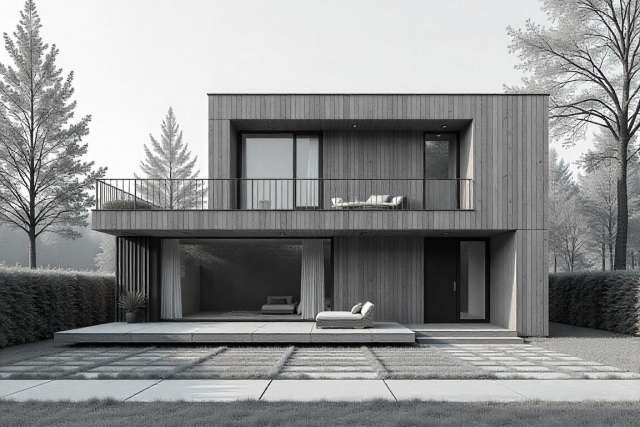The Comprehensive Homeowner's Guide to a Whole-Home Remodel: Process, People, and Pitfalls - part 4

The Future-Proofed Home
A successful whole-home remodel looks beyond the immediate satisfaction of new aesthetics and improved functionality. It presents a unique opportunity to fundamentally upgrade a home's performance, creating a living environment that is more sustainable, technologically advanced, healthier, and more resilient for the years to come. This forward-thinking approach ensures that the significant investment made in a remodel continues to provide value long after the construction dust has settled.
Building for Tomorrow: Sustainable Practices and Smart Technology
A modern renovation is an ideal moment to integrate systems and materials that align with contemporary standards of efficiency and connectivity. This not only enhances the daily living experience but also contributes to the long-term value and appeal of the property
Sustainable and Green Remodeling
A sustainable or "green" renovation is an approach that prioritizes environmental responsibility and resource efficiency. This methodology has tangible benefits, including lower utility bills (potentially reduced by up to 30%), improved indoor air quality through the use of non-toxic, low-VOC (volatile organic compound) materials, and increased home value—with some studies showing that green-certified homes can sell for up to 8% more than their non-certified counterparts. Key strategies for a sustainable remodel include:
- Energy Efficiency: This is the cornerstone of green building. It involves installing high-performance, double- or triple-glazed windows; upgrading insulation in walls and attics; and selecting modern, energy-efficient systems like solar panels, programmable thermostats, and tankless water heaters.
- Water Conservation: Installing low-flow fixtures for faucets, showerheads, and toilets can dramatically reduce a household's water consumption.
- Sustainable Materials: This involves choosing materials that are recycled, reclaimed (such as using wood from old structures), or rapidly renewable. This approach reduces waste and the environmental impact of manufacturing new materials.
- Green Roofing: For homes with flat or low-slope roofs, a green roof—a living layer of vegetation planted over a waterproofing membrane—offers multiple benefits. It insulates the home, manages stormwater runoff, purifies the air, and can significantly extend the life of the roof itself.
The Role of Technology in the Modern Remodel
Technology is transforming the remodeling industry, both in how projects are executed and in what a modern home can do.
- In the Process:
- 3D Design and Virtual Reality (VR): As detailed earlier, these visualization tools are becoming indispensable in the design phase. They allow homeowners to experience their new space immersively before construction, which improves communication, eliminates surprises, and ensures greater satisfaction with the final result.
- Project Management Software: The adoption of centralized software platforms is a hallmark of a modern, professional contractor. These tools provide a single portal for tracking schedules, monitoring the budget in real-time, storing documents, and managing all communication, bringing unprecedented transparency and efficiency to the process for both the contractor and the homeowner.
- ○ In the Home:
- Smart Home Integration: A whole-home remodel is the perfect opportunity to lay the infrastructure for a fully integrated smart home. This goes beyond standalone gadgets to creating a cohesive system. It involves planning for and installing wiring for automated lighting, smart thermostats (e.g., Google Nest), advanced security systems with cameras and smart locks, and connected appliances, all of which can be controlled from a central hub or smartphone.
- Future-Proofing: A forward-thinking approach to technology involves planning for the future. This means selecting systems that are modular and can be easily upgraded as technology evolves. It also means designing the home's infrastructure to accommodate future needs, such as running conduit for future wiring or ensuring robust Wi-Fi coverage throughout the house.
The decision to invest in "green" and "smart" technologies should be viewed not as a series of individual upgrades, but as the design of a holistic, high-performance home ecosystem. The true value of these systems is unlocked through their synergy. For example, a smart thermostat is significantly more effective at saving energy when it is controlling a high-efficiency HVAC system in a well-insulated and tightly sealed home. Solar panels can power the home's smart systems, reducing or even eliminating reliance on the electrical grid. This perspective shifts the concept of a house from a passive structure to an active, responsive system. A truly "future-proofed" home might use an integrated energy management system that analyzes data from its solar panels, the homeowner's usage patterns (gleaned from smart appliances), and the weather forecast to intelligently optimize energy consumption and storage. This level of integration requires a design and construction team that understands not just how to install individual products, but how to design and implement interconnected systems. The guiding question for the homeowner should be, "How can these technologies work together to create a home that is fundamentally more efficient, comfortable, resilient, and valuable?"
Conclusion
Embarking on a whole-home remodel is a journey of immense scope and complexity, demanding careful navigation through distinct phases of planning, execution, and emotional adaptation. The success of this endeavor is overwhelmingly determined by the diligence of the pre-construction phase. A clear definition of goals, a realistic and resilient budget with an adequate contingency fund, and the assembly of a trusted, professional team are the foundational pillars upon which a smooth project is built.
The process itself follows a critical, sequential path from the disruptive but necessary demolition and structural work, through the intricate installation of hidden mechanical systems, to the rewarding application of final finishes. Throughout this timeline, which can span from four months to over a year, homeowners will experience a predictable emotional rollercoaster, from initial excitement to a mid-project trough of stress and frustration, ultimately culminating in the joy and relief of a completed vision.
Navigating this journey requires a partnership between an informed homeowner and a process-driven contractor. The homeowner's role is to be decisive during planning, communicative during construction, and disciplined in the face of "scope creep." The contractor's role is to provide transparency, expert management, and proactive quality control. The adoption of modern tools—from 3D design software that clarifies vision to project management platforms that ensure transparency—is a key indicator of a firm's commitment to mitigating the common pain points of remodeling.
Ultimately, a whole-home remodel is an opportunity to create more than just an updated space. It is a chance to build a safer, healthier, more functional, and more efficient environment tailored perfectly to one's lifestyle. By understanding the process, anticipating the challenges, and preparing for the realities of the journey, homeowners can transform this daunting undertaking into one of the most rewarding investments they will ever make in their property and their quality of life.





